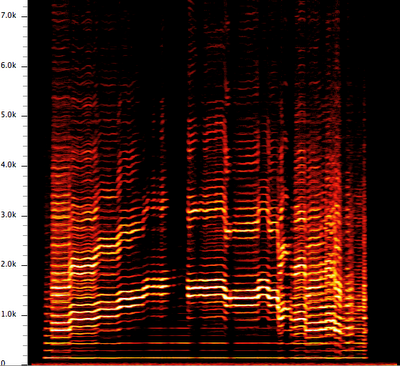Clarinet multiphonics
On July 4th at Ircam in Paris, during the July 2010 Prisma meeting, I included in my presentation a few sonograms of clarinet "multiphonic" sounds, these sounds in which one can hear more than one pitch at the same time.
Sonograms
I recorded these rough multiphonic clarinet sounds in Cambridge on Friday, June 19th, 2010. The four sound files are available on freesound: Clarinet multiphonics.
This is the sonogram of a rich multiphonic sound, commonly called a split tone. Here, it's played on a low fingered E (concert D), the lowest note of the Bb clarinet. The clarinet player can emphasize different harmonic regions. This is what Iannis Xenakis is calling for in his 1971 composition Charisma for clarinet and cello, when he writes Harm. Zone I, II, III, and IV.
To achieve this effect, the clarinet player modulates the air pressure and changes the shape of his/her vocal cavities. We see on the sonogram that this selective reinforcement of harmonic regions consists in moving two formants.
This second sonogram shows that on the same low E fingering, the clarinetist can choose which partials sound. This is the basic technique for producing notes in different registers. In normal clarinet playing, the selection of the register is done with the help of keys and fingerings, but the control of the air column and vocal track shape remains very important.
By using special fingerings, one can transform a unique clarinet into a dual sound generator. E. Michael Richards explains the phenomenon very well. The sonogram above corresponds to the example #2 on his page Clarinet multiple sounds - you'll find there the score and fingerings.
As you may know, the clarinet's bore is mostly cylindrical, and that results in very weak even harmonics in the sound. For instance, the octave is almost absent from the analysis of a clarinet sound. But if you find a special multiphonic fingering giving you a fundamental and its octave, you can really change the timbre of the instrument. The last sonogram illustrates such a sound, here with a fade from a note to its octave.
Clarinet acoustics
Here are a few good sources on the acoustics of the clarinet.
- a reference that Pr Heller used this year as a reading in his Harvard course The Physics of Music & SoundClarinet acoustics from the University New South Wales in Sidney.
- excerpts from Pr E. Michael Richards’s excellent book The clarinet of the 21st century.
- an important study of multiphonic sounds by French clarinetist Alain Sève:
And let me introduce two friends of mine. First, the excellent Michael Norsworthy, Boston-based clarinetist. In the following video, he demonstrates four types of multiphonics. By the way, he calls "overblowing" multiphonics the ones I call split tones.
Second, it looks like clarinetist Adam Berkowitz is going to talk about multiphonics in his upcoming book Four Extended Techniques for Clarinet: A Practical Guide. I'm looking forward to the publication...







Hi- I found your blog via the image of clarinet tone. Those could be beautiful abstract arts works.
ReplyDeleteI'll be linking to your blog on mine. Nice to meet you!
David